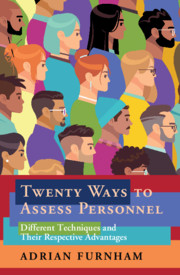Book contents
- Twenty Ways to Assess Personnel
- Twenty Ways to Assess Personnel
- Copyright page
- Dedication
- Contents
- Tables
- Preface
- Acknowledgements
- 1 Introduction to Selection and Assessment
- 2 Complex and Sticky Issues in Assessment and Selection
- 3 Traditional and Mainly Discredited Assessment Methods
- 4 Self-Report Tests
- 5 Observer Reports
- 6 Behavioural Tests
- 7 Physiology
- 8 Biography
- 9 Big Data
- 10 The Future of Assessment
- Index
- References
5 - Observer Reports
Published online by Cambridge University Press: 11 June 2021
- Twenty Ways to Assess Personnel
- Twenty Ways to Assess Personnel
- Copyright page
- Dedication
- Contents
- Tables
- Preface
- Acknowledgements
- 1 Introduction to Selection and Assessment
- 2 Complex and Sticky Issues in Assessment and Selection
- 3 Traditional and Mainly Discredited Assessment Methods
- 4 Self-Report Tests
- 5 Observer Reports
- 6 Behavioural Tests
- 7 Physiology
- 8 Biography
- 9 Big Data
- 10 The Future of Assessment
- Index
- References
Summary
This chapter covers three areas of research of interest to those in assessment: the accuracy and usefulness of others’/observers’ reports, namely references and testimonials; appraisals and reports by people at work who know the individual (boss, colleagues, reports, customers); and the electronic surveillance at work and home. Each method relies on observer reports which are often considered to be superior to self-reports, though they are highly reliant on both the observer’s actual ‘data’ on the individual, as well as the extent to which they are honest. One of the oldest, most established but least validated of methods is the use of personal references/testimonials by supposedly a person who knows a candidate well and is prepared to be honest. The second which comes from the USA more than 70 years ago remains very popular as much for development and training as assessment: similar ratings from different people at work on the same individual on various different aspects. The third area is perhaps the most controversial: the monitoring of individual through a variety (mostly electronic) means on all sorts of their behaviour at as well as to and from work. The newest method, namely wearables, is also discussed.
Keywords
- Type
- Chapter
- Information
- Twenty Ways to Assess PersonnelDifferent Techniques and their Respective Advantages, pp. 207 - 277Publisher: Cambridge University PressPrint publication year: 2021



